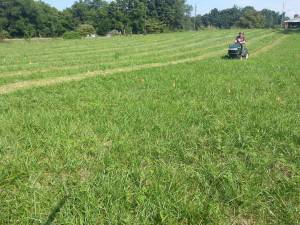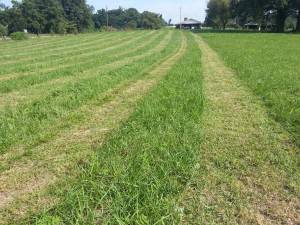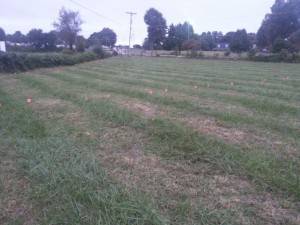With a field of corn, you get to redo the planting every year and you even rotate where it’ll be. But how do you figure out how a field should look for plants that will be there 10-12 years? It’s a semi-permanent design! We used to dream about how we’d lay out a field and talked about straight lines, designs, everything. But we couldn’t really work on it until we had the actual field – the shape, the dimensions, the slope, the surrounding area. So, from the first time we saw the land, we started planning – even before we owned it!
There’s the “front acre” and we wanted to start planting there. And we knew how we wanted the rows to run – or at least we did until we had a massive rain storm and saw some low lying areas. That changed how we ran some so of the rows! But how do we figure out how many plants will fit, what the spacing is, how many rows we’ll get, where to start and stop rows – so many questions. We started talking to the Landscape Architects about how to figure this out and they were able to take some general spacing and figure out how many plants. They had also given us a general suggestion of “mowing around areas to get a real feel” – and that’ll come back up later. But I wanted more specifics than that and I wanted them before we started tilling and putting in beds.
 Enter the $7.98 bundle of marking flags from the home improvement store! We could use those to mark the width of the row, the direction of the row – AND we could mow between the rows to get that real feel! I marked our spacing out on a stick and started putting flags in the ground. I even bought one of those measuring wheelie things – I never thought I’d own one of those living in a neighborhood! We got the whole acre flagged and mowed and measured. We got to see where we’d end and begin rows and how many plants we could put where. And that was exactly what we needed, that was our reality check. And that was the end of design 1. We made some changes and started on design 2 and didn’t even have to flag the whole field. Those flags were pulled up and design 3 was laid out. And that was the final design. Those simple tools – flags, measured stick, a measuring wheel, and mower let us not only envision, but see and touch our future field. It really allowed us to discuss possible issues, maintenance (how much room did the mower need to make a turn?), access, supplies, etc. We know there will be variation when we actually start laying the beds, but we’ve got a great jump on problem solving when the time comes.
Enter the $7.98 bundle of marking flags from the home improvement store! We could use those to mark the width of the row, the direction of the row – AND we could mow between the rows to get that real feel! I marked our spacing out on a stick and started putting flags in the ground. I even bought one of those measuring wheelie things – I never thought I’d own one of those living in a neighborhood! We got the whole acre flagged and mowed and measured. We got to see where we’d end and begin rows and how many plants we could put where. And that was exactly what we needed, that was our reality check. And that was the end of design 1. We made some changes and started on design 2 and didn’t even have to flag the whole field. Those flags were pulled up and design 3 was laid out. And that was the final design. Those simple tools – flags, measured stick, a measuring wheel, and mower let us not only envision, but see and touch our future field. It really allowed us to discuss possible issues, maintenance (how much room did the mower need to make a turn?), access, supplies, etc. We know there will be variation when we actually start laying the beds, but we’ve got a great jump on problem solving when the time comes.
– Mary B.




